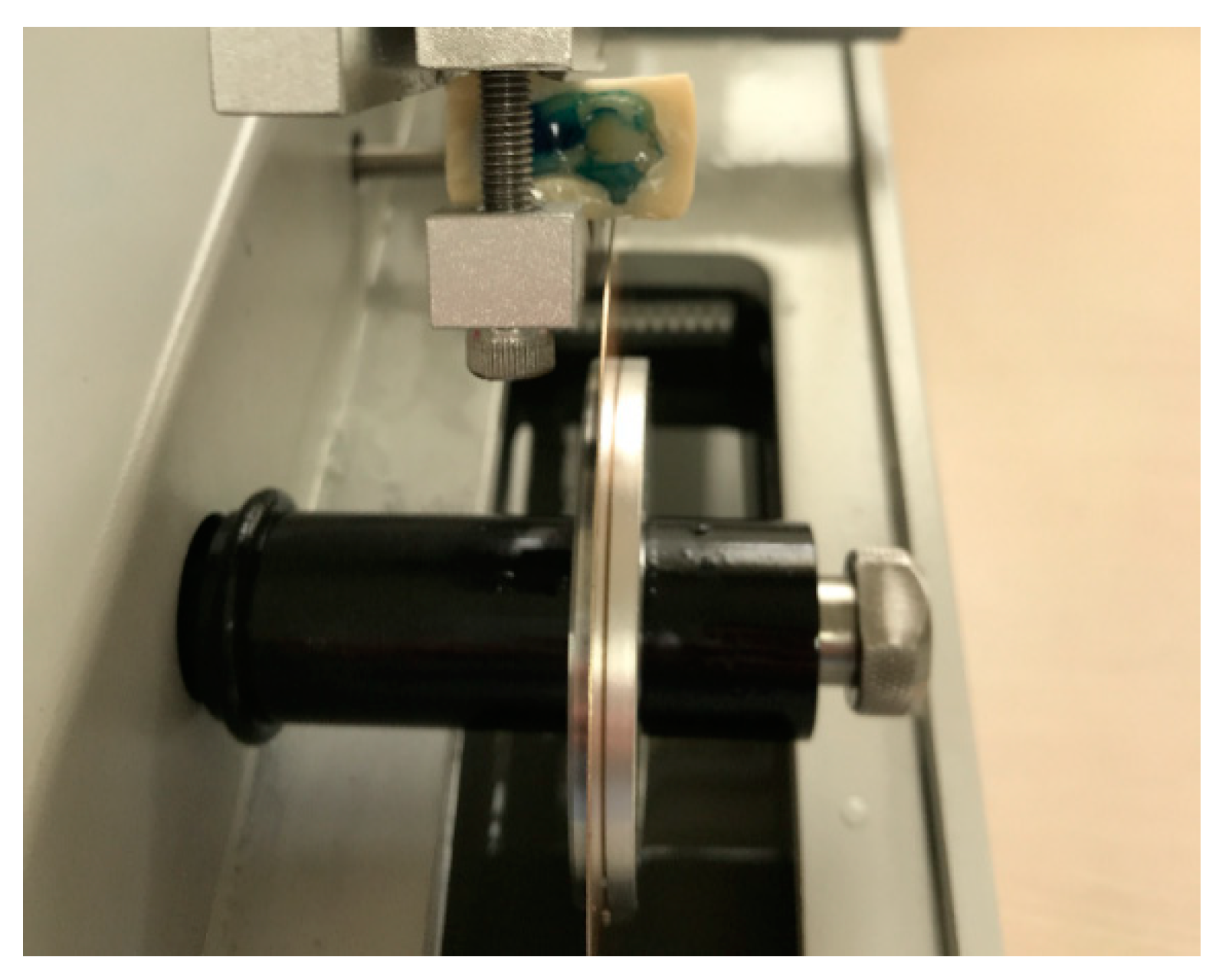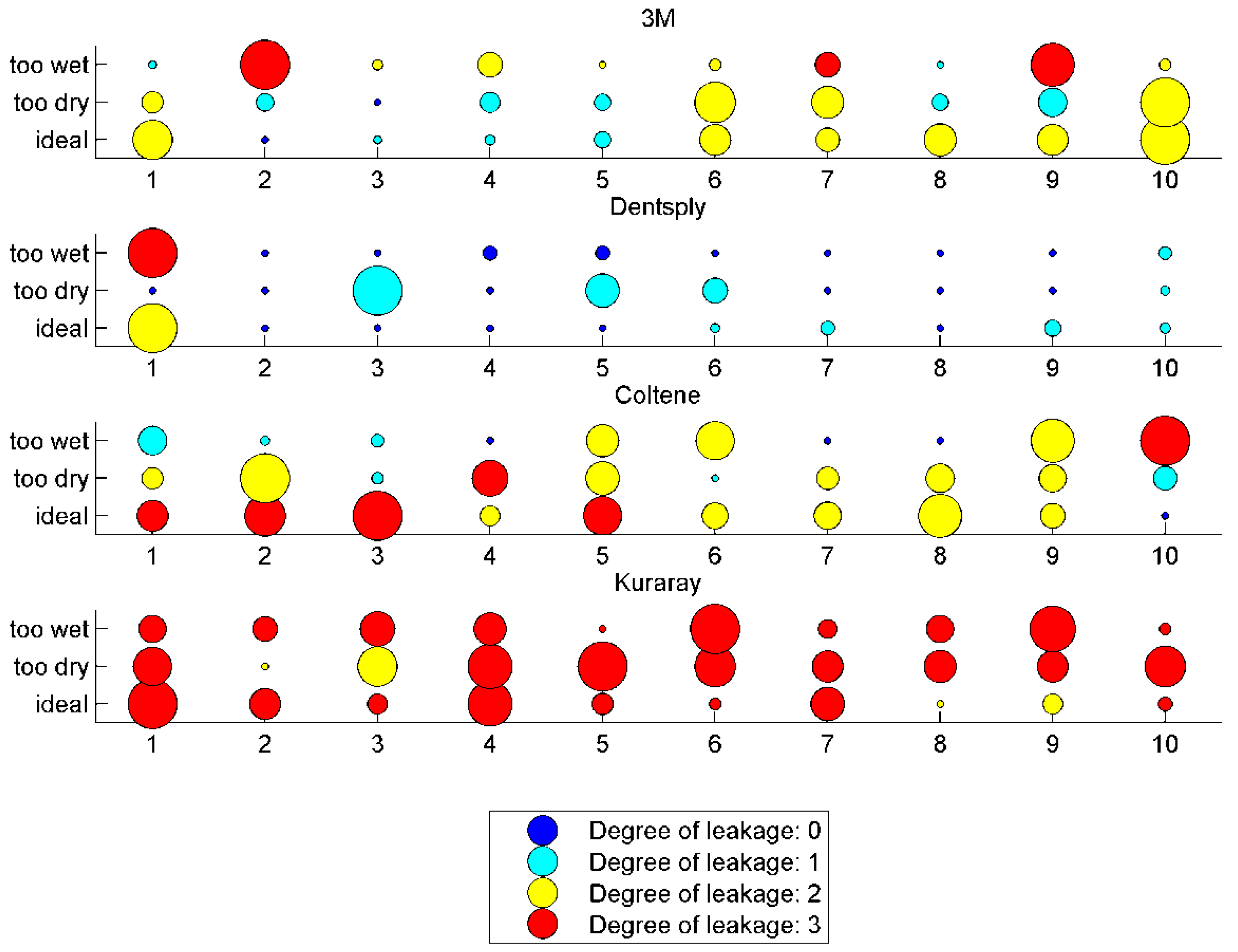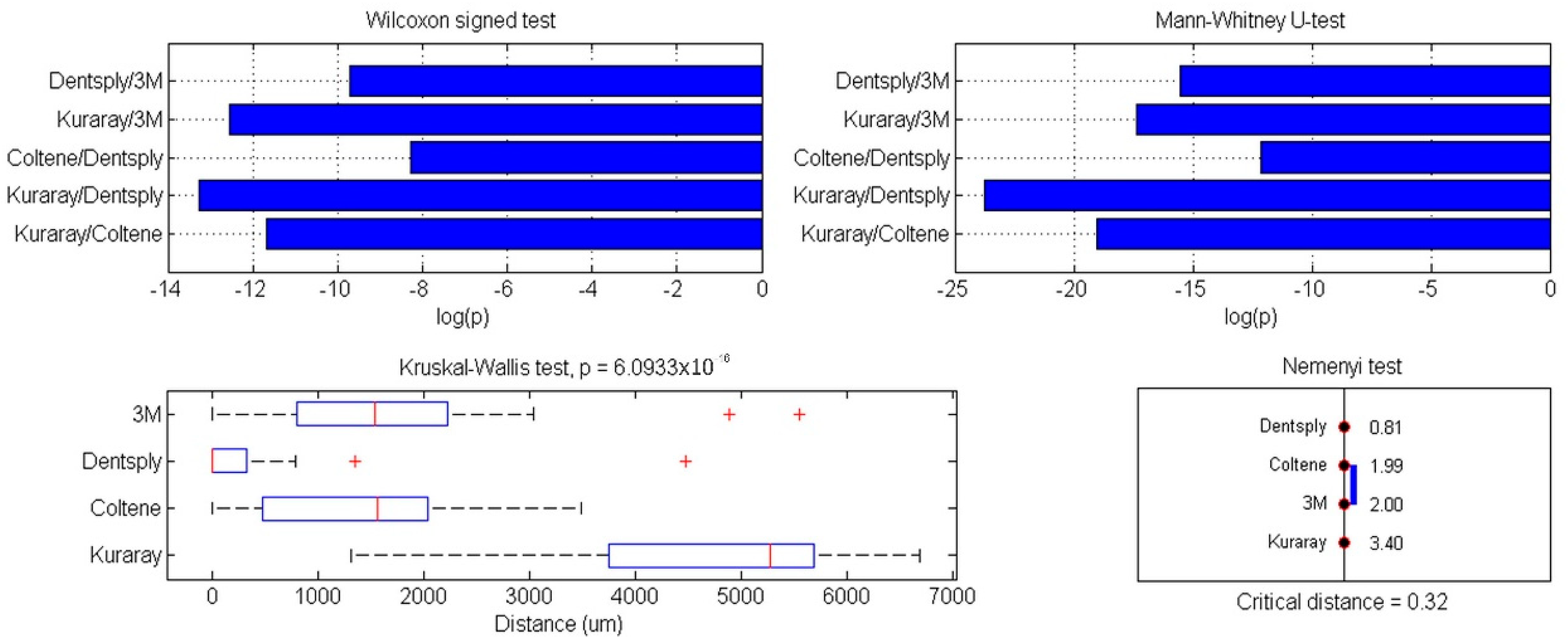In Vitro Analysis of Quality of Dental Adhesive Bond Systems Applied in Various Conditions
Abstract
1. Introduction
2. Materials and Methods
3. Results
4. Discussion
5. Conclusions
Author Contributions
Funding
Acknowledgments
Conflicts of Interest
Compliance with Ethical Standards
References
- Ozdogan, A.; Akyil, M.S.; Duymus, Z.Y. Evaluating the microleakage between dentin and composite materials. Dent. Med. Probl. 2018, 55, 261–265. [Google Scholar] [CrossRef] [PubMed]
- Gupta, A.; Tavane, P.; Gupta, P.K.; Tejolatha, B.; Lakhani, A.A.; Tiwari, R.; Kashyap, S.; Garg, G. Evaluation of microleakage with total etch, self-etch and universal adhesive systems in Class V restorations: An in vitro study. J. Clin. Diagn. Res. 2017, 11, ZC53–ZC56. [Google Scholar] [CrossRef] [PubMed]
- Fabianelli, A.; Pollington, S.; Davidson, C.; Cagidiaco, M.; Goracci, C. The Relevance of Micro-Leakage Studies. Int. Dent. SA 2007, 9, 64–74. [Google Scholar]
- Alhabdan, A.A. Review of microleakage evaluation tools. J. Int. Oral Health 2017, 9, 141–145. [Google Scholar] [CrossRef]
- Fortin, D.; Swift, E.J.; Denehy, G.E.; Reinhardt, J.W. Bond strength and microleakage of current dentin adhesives. Dent. Mater. 1994, 10, 253–258. [Google Scholar] [CrossRef]
- Hasegawa, T.; Retief, D.H.; Russell, C.M.; Denys, F.R. Shear bond strength and quantitative microleakage of a multipurpose dental adhesive system resin bonded to dentin. J. Prosth. Dent. 1995, 73, 432–438. [Google Scholar] [CrossRef]
- Ateyah, N.Z.; Elhejazi, A.A. Shear bond strengths and microleakage of four types of dentin adhesive materials. J. Contemp. Dent. Pract. 2004, 15, 63–73. [Google Scholar] [CrossRef]
- Moghaddas, M.J.; Moosavi, H.; Ghavamnasiri, M. Microleakage Evaluation of Adhesive Systems Following Pulp Chamber Irrigation with Sodium Hypochlorite. J. Dent. Res. Dent. Clin. Dent. Prospects 2014, 8, 21–26. [Google Scholar] [CrossRef]
- El Haddar, Y.S.; Cetik, S.; Bahrami, B.; Atash, R. A Comparative Study of Microleakage on Dental Surfaces Bonded with Three Self-Etch Adhesive Systems Treated with the Er: YAG Laser and Bur. Biomed. Res. Int. 2016, 2016, 2509757. [Google Scholar] [CrossRef][Green Version]
- Maas, M.S.; Alania, Y.; Natale, L.C.; Rodrigues, M.C.; Watts, D.C.; Braga, R.R. Trends in restorative composites research: What is in the future? Braz. Oral Res. 2017, 28, e55. [Google Scholar] [CrossRef]
- Matos, A.B.; Trevelin, L.T.; Silva, B.T.F.D.; Francisconi-Dos-Rios, L.F.; Siriani, L.K.; Cardoso, M.V. Bonding efficiency and durability: Current possibilities. Braz. Oral Res. 2017, 28, e57. [Google Scholar] [CrossRef] [PubMed]
- Faggion, C.M., Jr. Guidelines for reporting pre-clinical in vitro studies on dental materials. J. Evid. Based. Dent. Pract. 2012, 12, 182–189. [Google Scholar] [CrossRef] [PubMed]
- Osadcha, O.; Trzcionka, A.; Pachońska, K.; Pachoński, M. Detection of Dental Filling Using Pixels Color Recognition. In Communications in Computer and Information Science; Damaševičius, R., Vasiljevienė, G., Eds.; Springer: Cham, Switzerland, 2018; Volume 920, pp. 347–356. [Google Scholar] [CrossRef]
- Somani, R.; Jaidka, S.; Arora, S. Comparative evaluation of microleakage of newer generation dentin bonding agents: An in vitro study. Indian J. Dent. Res. 2016, 27, 86–90. [Google Scholar] [CrossRef] [PubMed]
- Zanatta, R.F.; Lungova, M.; Borges, A.B.; Torres, C.R.G.; Sydow, H.G.; Wiegand, A. Microleakage and shear bond strength of composite restorations under cycling conditions. Oper. Dent. 2017, 42, 71–80. [Google Scholar] [CrossRef]
- Bolgul, B.S.; Anya, B.; Simsek, I.; Celenk, S.; Seker, O.; Kilinc, G. Leakage testing for different adhesive systems and composites to permanent teeth. Niger. J. Clin. Pract. 2017, 20, 787–791. [Google Scholar] [CrossRef]
- Jacker-Guhr, S.; Ibarra, G.; Oppermann, L.S.; Luhrs, A.K.; Rahman, A.; Geurtsen, W. Evaluation of microleakage in class V composite restorations using dye penetration and micro-CT. Clin. Oral Investig. 2016, 20, 1709–1718. [Google Scholar] [CrossRef]
- Mozaffari, H.R.; Ehteshami, A.; Zallaghi, F.; Chiniforush, N.; Moradi, Z. Microleakage in Class V Composite Restorations after Desensitizing Surface Treatment with Er: YAG and CO2 Lasers. Laser Ther. 2016, 25, 259–266. [Google Scholar] [CrossRef]
- Phanombualert, J.; Chimtim, P.; Heebthamai, T.; Weera-Archakul, W. Microleakage of Self-Etch Adhesive System in Class V Cavities Prepared by Using Er:YAG Laser with Different Pulse Modes. Photomed. Laser Surg. 2015, 33, 467–472. [Google Scholar] [CrossRef]
- Muhammed, G.; Dayem, R. Evaluation of the microleakage of different class V cavities prepared by using Er:YAG laser; ultrasonic device, and conventional rotary instruments with two dentin bonding systems (an in vitro study). Lasers Med. Sci. 2015, 30, 969. [Google Scholar] [CrossRef]
- Al Shayeb, K.N.; Turner, W.; Gillam, D.G. Accuracy and reproducibility of probe forces during simulated periodontal pocket depth measurements. Saudi Dent. J. 2014, 26, 50–55. [Google Scholar] [CrossRef]
- Cevik, P.; Eraslan, O.; Eser, K.; Tekeli, S. Shear bond strength of ceramic brackets bonded to surface-treated feldspathic porcelain after thermocycling. Int. J. Artif. Organs 2018, 41, 160–167. [Google Scholar] [CrossRef] [PubMed]
- Noda, Y.; Nakajima, M.; Takahashi, M.; Mamanee, T.; Hosaka, K.; Takagaki, T.; Ikeda, M.; Foxton, R.M.; Tagami, J. The effect of five kinds surface treatment agents on the bond strength to various ceramics with thermocycler aging. Dent. Mater. J. 2017, 36, 755–761. [Google Scholar] [CrossRef] [PubMed]
- Söderholm, K.J.M. Coatings in dentistry—A review of some basic principles. Coatings 2012, 2, 138–159. [Google Scholar] [CrossRef]
- Maj, A.; Trzcionka, A.; Twardawa, H.; Tanasiewicz, M. A comparative clinical study of the self- adhering Flowable composite resin Vertise Flow and the traditional flowable resin Premise Flow. Coatings 2020, 10, 800. [Google Scholar] [CrossRef]
- Fujiwara, S.; Takamizawa, T.; Barkmeier, W.W.; Tsujimoto, A.; Imai, A.; Watanabe, H.; Erickson, R.L.; Latta, M.A.; Toshiyuki, N.; Miyazaki, M. Effect of double-layer application on bond quality of adhesive systems. J. Mech. Behav. Biomed. Mater. 2018, 77, 501–509. [Google Scholar] [CrossRef]
- Vichi, A.; Margvelashvili, M.; Goracci, C.; Papacchini, F.; Ferrari, M. Bonding and sealing ability of a new self-adhering flowable composite resin in class I restorations. Clin. Oral Investig. 2013, 17, 1497–1506. [Google Scholar] [CrossRef]
- Chen, C.; Niu, L.-N.; Xie, H.; Zhang, Z.-Y.; Zhou, L.-Q.; Jiao, K.; Chen, J.-H.; Pashley, D.H.; Tay, F.R. Bonding of universal adhesives to dentine—Old vine in new bottles? J. Dent. 2015, 43, 525–536. [Google Scholar] [CrossRef]








| Adhesive Bond | Specification | Application |
|---|---|---|
| 3M ESPE “Single Bond” | Methacryloyloxydecyl dihydrogen phosphateMDP Phosphate Monomer, Dimethacrylate resins, hydroxyethylmethacrylate (HEMA), Vitrebond™ Copolymer, Filler, Ethanol, Water, Initiators, Silane | Apply with the microbrush for 20 s, apply air for 5 s, light cure for 10 s. |
| Dentsply “Prime and Bond Active” | Bi- and multifunctional acrylate (bisphenol A-glycidyl methacrylate (bisGMA), urethane dimethacrylate (UDMA), trithylene glycol dimethacrylate(TEGDMA)), Phosphoric acid modified acrylate resin (PENTA, MDP), Initiator, Stabilizer, Isopropanol, Water | Apply adhesive, slight agitation, mild air blowing (>5 s), light cure for 10 s. |
| Coltene “One Coat 7 Universal | Metacrilatos (MDP), photoinitiators, ethanol, water | Apply with a microbrush, scrub for 20 s, gentle air drying for 5 s, light cure for 10 s. |
| Kuraray “Clearfil Universal Bond Quick” | HEMA, bisGMA, MDP, hidrophylic amid monomers, colloidal silica, silane, natrium fluoride, ethanol, water, initiator, activator | Apply in rubbing motion, air blowing (≥5 s), light cure for 10 s. |
© 2020 by the authors. Licensee MDPI, Basel, Switzerland. This article is an open access article distributed under the terms and conditions of the Creative Commons Attribution (CC BY) license (http://creativecommons.org/licenses/by/4.0/).
Share and Cite
Trzcionka, A.; Narbutaite, R.; Pranckeviciene, A.; Maskeliūnas, R.; Damaševičius, R.; Narvydas, G.; Połap, D.; Mocny-Pachońska, K.; Wozniak, M.; Tanasiewicz, M. In Vitro Analysis of Quality of Dental Adhesive Bond Systems Applied in Various Conditions. Coatings 2020, 10, 891. https://doi.org/10.3390/coatings10090891
Trzcionka A, Narbutaite R, Pranckeviciene A, Maskeliūnas R, Damaševičius R, Narvydas G, Połap D, Mocny-Pachońska K, Wozniak M, Tanasiewicz M. In Vitro Analysis of Quality of Dental Adhesive Bond Systems Applied in Various Conditions. Coatings. 2020; 10(9):891. https://doi.org/10.3390/coatings10090891
Chicago/Turabian StyleTrzcionka, Agata, Ruta Narbutaite, Alma Pranckeviciene, Rytis Maskeliūnas, Robertas Damaševičius, Gintautas Narvydas, Dawid Połap, Katarzyna Mocny-Pachońska, Marcin Wozniak, and Marta Tanasiewicz. 2020. "In Vitro Analysis of Quality of Dental Adhesive Bond Systems Applied in Various Conditions" Coatings 10, no. 9: 891. https://doi.org/10.3390/coatings10090891
APA StyleTrzcionka, A., Narbutaite, R., Pranckeviciene, A., Maskeliūnas, R., Damaševičius, R., Narvydas, G., Połap, D., Mocny-Pachońska, K., Wozniak, M., & Tanasiewicz, M. (2020). In Vitro Analysis of Quality of Dental Adhesive Bond Systems Applied in Various Conditions. Coatings, 10(9), 891. https://doi.org/10.3390/coatings10090891







